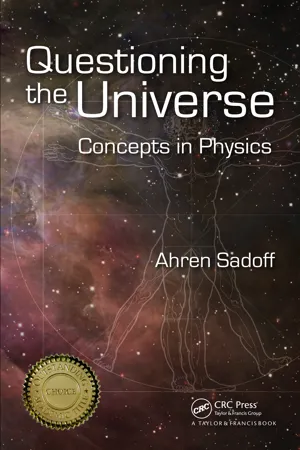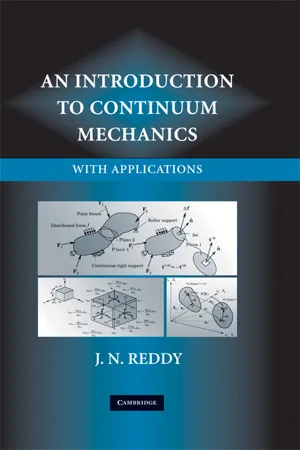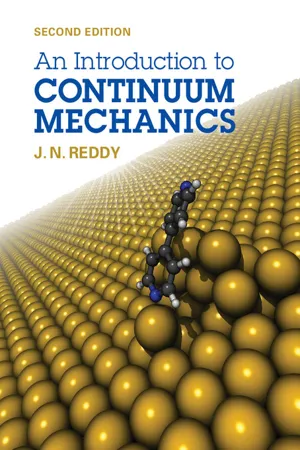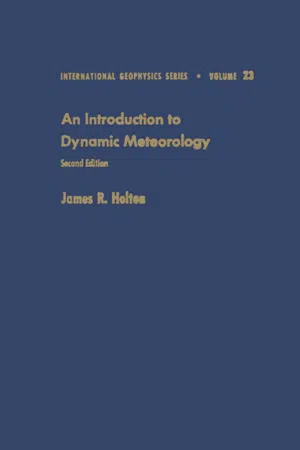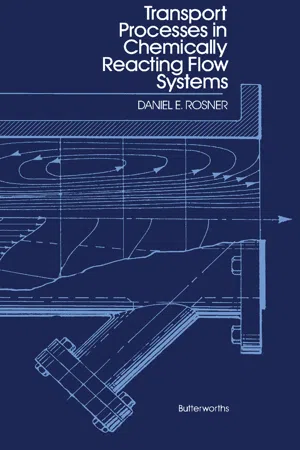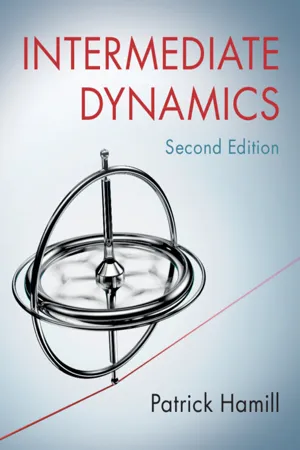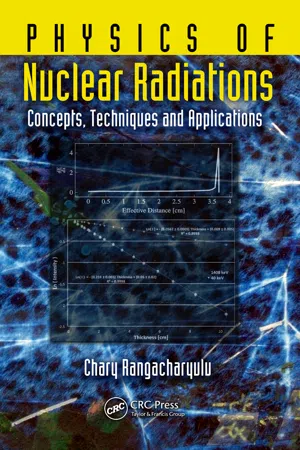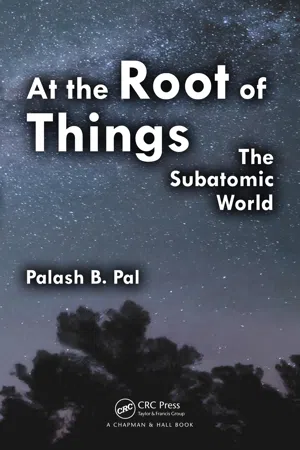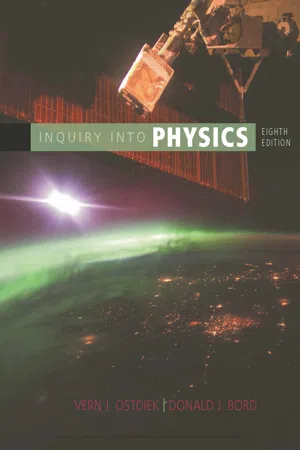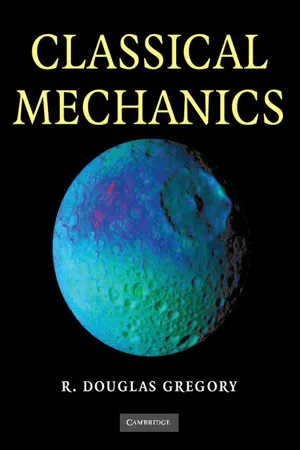Physics
Conservation Laws
Conservation laws in physics refer to fundamental principles that state certain physical quantities, such as energy, momentum, and electric charge, remain constant in isolated systems over time. These laws are essential for understanding and predicting the behavior of physical systems and are widely used in various branches of physics, including mechanics, thermodynamics, and electromagnetism.
Written by Perlego with AI-assistance
Related key terms
1 of 5
12 Key excerpts on "Conservation Laws"
- eBook - PDF
Questioning the Universe
Concepts in Physics
- Ahren Sadoff(Author)
- 2008(Publication Date)
- Chapman and Hall/CRC(Publisher)
61 8 Conservation Laws Conservation Laws are extremely important in physics. They are relevant to a wide variety of physical phenomena. They are very powerful and hence very useful. And interestingly, they follow directly from the symmetry principles we discussed in the last chapter. We can see this by just considering what it means if something is conserved. If something is conserved, it does not increase or decrease; it does not change; it does not vary. In other words, it remains invariant . So, we can give the following definition to conservation: Something is conserved if we can do something to it such that afterwards it remains invariant. Of course, this sounds almost identical to our definition of symmetry. It is no acci-dent. Emmy Noether, a woman mathematician, proved that symmetry principles lead directly to Conservation Laws. For instance, space translation symmetry leads to the conservation of momentum, and time translation symmetry leads to the conserva-tion of energy. We will discuss both of these Conservation Laws in this chapter. Using these as examples, we will be able to see why Conservation Laws are so powerful. 8.1 CONSERVATION OF MOMENTUM The word momentum is often used in everyday speech to imply that something is in motion. But in physics, momentum has a very well-defined meaning. The momen-tum of a single object with a mass, m, is given by the equation p = m v (8.1) Momentum is a vector quantity since it is directly proportional to the velocity vec-tor. The units of momentum are [Kg][M]/[s]. Many quantities in physics have units named after some famous physicist. For instance, the unit of force is the Newton for Isaac Newton. But no one has been honored for momentum. If there is a group of objects and we are interested in the momentum of the entire system, then we just add up the momentum of the individual objects to get the momentum of the system. - eBook - PDF
- J. N. Reddy(Author)
- 2007(Publication Date)
- Cambridge University Press(Publisher)
5 Conservation of Mass, Momenta, and Energy Although to penetrate into the intimate mysteries of nature and thence to learn the true causes of phenomena is not allowed to us, nevertheless it can happen that a certain fictive hypothesis may suffice for explaining many phenomena. Leonard Euler Nothing is too wonderful to be true if it be consistent with the laws of nature. Michael Faraday 5.1 Introduction Virtually every phenomenon in nature, whether mechanical, biological, chemical, geological, or geophysical, can be described in terms of mathematical relations among various quantities of interest. Most mathematical models of physical phe- nomena are based on fundamental scientific laws of physics that are extracted from centuries of research on the behavior of mechanical systems subjected to the ac- tion of natural forces. What is most exciting is that the laws of physics, which are also termed principles of mechanics, govern biological systems as well (because of mass and energy transports). However, biological systems may require addi- tional laws, yet to be discovered, from biology and chemistry to complete their description. This chapter is devoted to the study of fundamental laws of physics as applied to mechanical systems. The laws of physics are expressed in analytical form with the aid of the concepts and quantities introduced in previous chapters. The laws or principles of physics that we study here are (1) the principle of conservation of mass, (2) the principle of conservation of linear momentum, (3) the principle of conserva- tion of angular momentum, and (4) the principle of conservation of energy. These laws allow us to write mathematical relationships – algebraic, differential, or integral type – of physical quantities such as displacements, velocities, temperature, stresses, and strains in mechanical systems. The solution of these equations represents the response of the system, which aids the design and manufacturing of the system. - eBook - PDF
Principles of Continuum Mechanics
Conservation and Balance Laws with Applications
- J. N. Reddy(Author)
- 2017(Publication Date)
- Cambridge University Press(Publisher)
5 CONSERVATION OF MASS AND BALANCE OF MOMENTA AND ENERGY It is the mark of an educated mind to be able to entertain a thought without accepting it. Aristotle An error does not become truth by reason of multiplied propagation, nor does truth become error because nobody sees it. Mahatma Gandhi 5.1 Introduction 5.1.1 Preliminary Comments Most phenomena in nature, whether mechanical, biological, chemical, geologi-cal, or geophysical can be described, based on the goal of the study, in terms of mathematical relations among various quantities of interest. Such relationships are called mathematical models and are based on fundamental scientific laws of physics that are extracted from centuries of research on the behavior of mechan-ical systems subjected to the action of external stimuli. What is most exciting is that the laws of physics also govern biological systems because of mass and energy transports. However, biological systems may require additional laws, yet to be discovered, from biology and chemistry to complete their description. This chapter is devoted to the study of fundamental laws of physics as applied to mechanical systems. The laws of physics are expressed in analytical form with the aid of the concepts and quantities introduced in previous chapters. The laws or principles of physics that we study here are: (1) the principle of conservation of mass, (2) the principle of balance of linear momentum, (3) the principle of bal-ance of angular momentum, and (4) the principle of balance of energy. These laws allow us to write mathematical relationships – algebraic, differential, or integral type – of physical quantities of interest such as displacement, velocity, temper-ature, stress, and strain in mechanical systems. The solution of these equations represents the response of the system, which aids the design and manufacturing of the system. - eBook - PDF
- J. N. Reddy(Author)
- 2013(Publication Date)
- Cambridge University Press(Publisher)
181 5 CONSERVATION AND BALANCE LAWS Although to penetrate into the intimate mysteries of nature and thence to learn the true causes of phenomena is not allowed to us, nevertheless it can happen that a certain fictive hypothesis may suffice for explaining many phenomena. —– Leonard Euler (1707–1783) Nothing is too wonderful to be true if it be consistent with the laws of nature. —– Michael Faraday (1791–1867) 5.1 Introduction Virtually every phenomenon in nature can be described in terms of mathemati-cal relations among certain quantities that are responsible for the phenomenon. Most mathematical models of physical phenomena are based on fundamental scientific laws of physics that are extracted from centuries of observations and research on the behavior of mechanical systems subjected to the action of natural forces. The most exciting thing about the laws of physics, which are also termed principles of mechanics , is that they govern biological systems as well (because of mass and energy transports). However, biological systems may require ad-ditional laws, yet to be discovered, from biology and chemistry to reasonably complete their descriptions. This chapter is devoted to the study of fundamental laws of physics and resulting mathematical models as applied to mechanical systems. The laws of physics are expressed in analytical form with the aid of the concepts and quantities introduced in the previous chapters. The principles of mechanics to be studied are (1) the principle of conservation of mass, (2) the principle of balance of linear momentum, (3) the principle of balance of angular momentum, and (4) the principle of balance of energy. These principles allow us to write mathematical relationships – algebraic, differential, or integral type – between quantities such as displacements, velocities, temperature, stresses, and strains that arise in mechanical systems. - eBook - PDF
Atmosphere, Ocean and Climate Dynamics
An Introductory Text
- John Marshall, R. Alan Plumb(Authors)
- 1979(Publication Date)
- Academic Press(Publisher)
Chapter 2 The Basic Conservation Laws Atmospheric motions are governed by three fundamental physical prin- ciples : conservation of mass, conservation of momentum, and conservation of energy. The mathematical relations which express these laws may be derived by considering the budgets of mass, momentum, and energy for an infinitesimal control volume in the fluid. Two types of control volumes are commonly used in fluid dynamics. In the eulerian frame of reference the control volume consists of a parallelepiped of sides 6x, 6y, 6z whose position is fixed relative to the coordinate axes. Mass, momentum, and energy budgets will depend on fluxes due to the flow of fluid through the boundaries of the control volume. (This type of control volume was used in Section 1.4.1.) In the lagrangian frame, however, the control volume consists of an infinitesimal mass of “tagged” fluid particles; thus, the control volume moves about following the motion of the fluid, always containing the same fluid particles. The lagrangian frame is particularly useful for deriving Conservation Laws since such laws may be stated most simply in terms of a particular mass element of the fluid. The eulerian system is, however, more convenient for solving most problems because in that system the field variables are related by a set of partial differential equations in which the independent variables are the coordinates x, y, z , t. In the lagrangian system, on the other hand, ‘6 2.1 TOTAL DIFFERENTIATION 27 it is necessary to follow the time evolution of the fields for various individual fluid parcels. Thus the independent variables are xo, y o , zo, and t, where xo, yo, zo designate the position which a particular parcel passed through at a reference time to. 2.1 Total Differentiation The Conservation Laws to be derived in this chapter contain expressions for the rates of change per unit volume of mass, momentum, and thermo- dynamic energy following the motion of particular fluid parcels. - eBook - PDF
Transport Processes in Chemically Reacting Flow Systems
Butterworths Series in Chemical Engineering
- Daniel E. Rosner, Howard Brenner(Authors)
- 2013(Publication Date)
- Butterworth-Heinemann(Publisher)
2 Governing Conservation Principles INTRODUCTION Approach Chemically reacting fluids, including gas mixtures, can be quantitatively understood in terms of two types of laws applied to matter treated as a continuum: a. Conservation Laws, which summarize the experience of the last three centuries on the behavior of all forms of matter; b. Constitutive laws, which quantitatively describe the behavior of certain subclasses of fluids (e.g., perfect gas mixtures, elastic solids, etc.). The conservation principles, to which we first direct our attention, ensure that, for any fluid, in any state of motion, the following quantities are either conserved or, more generally, balanced: Mass Momentum Energy Entropy 1 I Total mixture mass Individual chemical species (e.g., C H 4 , 0 2 , C 0 2 , etc.) mass Individual chemical element (e.g., C, O, S, N, etc.) mass [Total linear momentum of the mixture (a vector) [Total angular momentum of the mixture (a vector) [Total energy (thermodynamic + kinetic) (First Law of | Thermodynamics) [Kinetic (mechanical) energy Total entropy of mixture (describing the consequences of transformations between forms of energy that are not thermodynamically equivalent (Second Law) and identifying all sources of irreversibility and the nature of entropy transport by diffusion). 1 From the Greek: εντρωπη, meaning evolution. 27 28 Introduction Each of these quantities is associated with a field density, i.e., a spatial concentration of that quantity, related, in turn, to the local material mass density, as shown in Table 2-1. Note that while most of these field densities are scalars (defined by one number at each point/instant), pv is a vector field (defined by three numbers at each point/instant). These conservation principles apply not only to any fluid, but to any region of space (subject to the continuum restriction). Thus, we state them below in three important forms, applicable to a control volume (CV) that is: in. - eBook - PDF
- Patrick Hamill(Author)
- 2022(Publication Date)
- Cambridge University Press(Publisher)
(We will consider the conservation of parity briefly in Chapter 8.) 136 5 ENERGY It has been suggested that Conservation Laws are not laws of nature, but just mental constructs designed to help us comprehend and deal with the physical world. The law of conservation of energy is often cited as an example of this point of view. In your introductory physics course you learned the law of conservation of energy in the form: kinetic energy + potential energy = constant. When you studied thermodynamics you learned that mechanical energy could be converted into heat and you modified the law to: kinetic energy + potential energy + thermal energy = constant. Then you studied electricity and magnetism and learned of other forms of energy associated with the electromagnetic fields. These also had to be included in the conservation law. And so on. . . This procedure gives the impression that every time we find a new form of energy we simply add it to the left-hand side of the equation and define energy as that quantity whose total value is constant. However, such an approach tends to trivialize the Conservation Laws and we shall not adopt it. We shall consider the Conservation Laws to be fundamental to the structure of the physical universe. As shown in Chapter 8, the Conservation Laws are related, on a very profound level, to symmetries found in nature. Thus, energy conservation is related to a symmetry in time and momentum conservation is related to a symmetry in space. (I really don’t expect you to understand what I am talking about here – but don’t worry, it will all become clear as we go along!) 5.6 Energy Diagrams Imagine a particle that is initially at the top of a perfectly smooth hill, as illustrated in Figure 5.10 which shows the particle perched on a peak at point A. There are peaks at A, C, and E and valleys at B and D. The only force acting on the particle is gravity. The particle is given an infinitesimal push to the right. - eBook - PDF
Physics of Nuclear Radiations
Concepts, Techniques and Applications
- Chary Rangacharyulu(Author)
- 2013(Publication Date)
- CRC Press(Publisher)
So far, no phenomenon that disobeys any one of 1 2 Physics of Nuclear Radiations: Concepts, Techniques and Applications these laws has been discovered. These three Conservation Laws are discussed below. Conservation of Total Energy Mass is a form of energy. Kinetic en-ergy and mass are attributes of a body in motion. Kinetic energy and mass are separately conserved in elastic processes. The departure from classical concepts is that mass is not necessarily conserved in atomic or nuclear processes. Inelastic processes, involving emis-sion or absorption of radiation, or changing the composition of in-teracting partners, do not conserve the mass or kinetic energy. Total energy, however, is conserved. Prior to relativity, inelastic processes accompanied by energy dis-sipation were known. This is what happens in chemical reactions resulting in the formation of compounds. In relativity, we realize that processes where interacting partners reorganize themselves to another set of constituents can result in non-conservation of total mass. Also the kinetic energy of the system is not conserved in in-elastic processes. The problem is now simplified since we mainly require the conservation of two kinematic parameters, i.e., total en-ergy and total momentum. It is interesting to note that such trans-formations almost always lead to loss of total mass, consistent with the principle: left to itself, a system evolves to a state of lowest energy . As we will see in Chapter 2, nuclear decay processes are governed by this principle. The Conservation of Linear Momentum This physics principle is as old, at least, as Newton’s Laws of Motion. It still holds very rigorously for all processes. Linear momentum is a vector quan-tity. We require that the vector sum of momenta of all interacting partners remain unchanged during the process. This implies that the momentum components along each of the mutually orthogonal directions must be separately conserved. - eBook - PDF
At the Root of Things
The Subatomic World
- Palash Baran Pal(Author)
- 2014(Publication Date)
- CRC Press(Publisher)
In general, we could say that every conservation law has an underlying symmetry associated with it. Alternatively, a symmetry always gives rise to a conservation law. Exactly that’s what Noether said in 1918. Since then the concepts of ’symmetry’ and ‘conservation law’ have become synony-mous. Consider this. We had obtained the momentum con-servation from Newton’s laws for the first time. Later the limitations of Newton’s laws have been discovered and we have learnt that Newton’s definition of momentum needs to be modified. We also had to add the momentum of the fields, and to remember that the kinetic mass depends on the velocity of an object. Even after all these corrections, the Conservation Laws hold good. Perhaps someday we would find the limitations of Einstein’s theory, or certain weak-nesses of Maxwell’s field theory. But whatever new theories may come, if the concept of translational symmetry of space is not discarded then we shall always find a quantity which would be conserved. And this quantity would be known as momentum then. We have already said that a physicist must have faith in symmetries. If it so happens that the laws he discovers here are not applicable at another point in space, then such laws are completely useless to him. If the laws of nature change from time to time, then what use is all the hard work to uncover them? This is why the Conservation Laws are so important. This is why the role of symmetry in the drama of physics is so magnificent. The faithful say that only faith can find God. We shall end this chapter by an example of what faith, in conser- 42 Ch. 1: Conservation Laws vation laws, has given science. In the beginning of the twentieth century it became known that the nuclei of cer-tain elements decay spontaneously and electrons come out of them. But sum of the momenta of the electron and the nuclei did not equal the momentum of the original nuclei. Some people said, get rid of such Conservation Laws. - eBook - PDF
- Vern Ostdiek, Donald Bord(Authors)
- 2017(Publication Date)
- Cengage Learning EMEA(Publisher)
82 Chapter 3 Energy and Conservation Laws assess what was going on just before the crash, based on information about how things are immediately afterward. In so doing, it becomes possible to understand what the pre-crash circumstances were like and to establish, for example, whether one car was exceeding the speed limit, whether one or both drivers were applying their brakes or attempting to take evasive action, or if one car had drifted across the median into the lane of the other, oncoming car. Such conclusions can significantly influence the outcomes of legal proceedings following a serious accident in which lives or property are lost. In this chapter, we introduce the use of Conservation Laws of linear momentum, energy, and angular momen - tum in the study of how objects move. These laws are sim - ple but powerful tools for analyzing complex interactions of all types—not just collisions—that we could not handle using only the concepts from Chapter 2. Work and power, two important physical quantities related to energy, are introduced as well. The concept of energy is one of the most important in physics, and its usefulness extends well beyond the area of mechanics. CHAPTER INTRODU C T I ON: Forensic P hysics The squealing tires. The screeching brakes. The crunching of metal and popping of glass. These are the sounds of a car crash (Figure CO-3 ). Is anyone hurt? How badly? Has someone called the EMTs? These questions and more are quickly asked in the aftermath of a vehicle collision as im - mediate efforts are made to save lives and property. But eventually other questions surface: How did this happen? Was someone speeding? Who is at fault? Who is responsi - ble for the damages? The answers to these questions often require the intervention of law enforcement officials, legal counselors and officers of the court, and perhaps surpris - ingly, physicists. - Javier Bonet, Antonio J. Gil, Richard D. Wood(Authors)
- 2021(Publication Date)
- Cambridge University Press(Publisher)
Casting the governing equations describing the motion of solids in the form of a set of first-order Conservation Laws therefore has advan- tages. First, it allows the use of a wide variety of robust discretization techniques developed in other areas of computational physics. Second, it makes it possible to introduce additional variables and physical features such as thermal effects within a unified formulation. A computational framework based on these Conservation Laws for the simulation of solid dynamics will be presented in detail in Chapter 7 together with an associated program described in Chapter 9. 157 158 Conservation Laws IN SOLID DYNAMICS The following sections will begin with a description of the general form of a con- servation law before applying this to both the Lagrangian and Eulerian descriptions of motion. 5.2 THE GENERAL FORM OF A CONSERVATION LAW Before discussing in detail the Conservation Laws governing solid dynamics, it is useful to consider the general form of such laws in a three-dimensional space described by Cartesian coordinates x 1 ,x 2 , and x 3 . No distinction is made at this juncture between reference or spatial coordinates, so that x 1 ,x 2 , and x 3 will be simply replaced by X 1 ,X 2 , and X 3 when formulating the Conservation Laws in a Lagrangian setting. Consider now a variable U (x,t), representing the amount per unit volume of a physical quantity Q(t) at a spatial point x and time t. In essence, U represents the concentration or spatial density of Q, which can therefore be calculated over an arbitrary volume v as Q(t) = v U (x,t) dv. (5.1) For instance, if Q denotes the mass m, then U (x,t) represents the density ρ. The rate of change of Q can be decomposed into a volume component measuring the amount of Q that is inserted or removed at each spatial point and a surface compo- nent measuring the amount of Q that flows in or out through the surface boundary of v.- eBook - PDF
- R. Douglas Gregory(Author)
- 2006(Publication Date)
- Cambridge University Press(Publisher)
Part Two MULTI-PARTICLE SYSTEMS AND CONSERVATION PRINCIPLES CHAPTERS IN PART TWO Chapter 9 The energy principle Chapter 10 The linear momentum principle Chapter 11 The angular momentum principle Chapter Nine The energy principle and energy conservation KEY FEATURES The key features of this chapter are the energy principle for a multi-particle system, the poten- tial energies arising from external and internal forces, and energy conservation. This is the first of three chapters in which we study the mechanics of multi-particle systems. This is an important development which greatly increases the range of problems that we can solve. In particular, multi-particle mechanics is needed to solve problems involving the rotation of rigid bodies. The chapter begins by obtaining the energy principle for a multi-particle system. This is the first of the three great principles of multi-particle mechanics ∗ that apply to every mechanical system without restriction. We then show that, under appropriate conditions, the total energy of the system is conserved. We apply this energy conservation principle to a wide variety of systems. When the system has just one degree of freedom, the energy conservation equation is sufficient to determine the whole motion. 9.1 CONFIGURATIONS AND DEGREES OF FREEDOM A multi-particle system S may consist of any number of particles P 1 , P 2 , . . ., P N , with masses m 1 , m 2 . . ., m N respectively. † A possible ‘position’ of the system is called a configuration. More precisely, if the particles P 1 , P 2 , . . ., P N of a system have position vectors r 1 , r 2 , . . ., r N , then any geometrically possible set of values for the posi- tion vectors { r i } is a configuration of the system. If the system is unconstrained, then each particle can take up any position in space (independently of the others) and all choices of the { r i } are possible.
Index pages curate the most relevant extracts from our library of academic textbooks. They’ve been created using an in-house natural language model (NLM), each adding context and meaning to key research topics.
